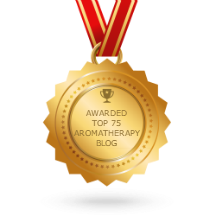Aniseed Myrtle, or Ringwood, is the topic of
discussion today. Backhousia anisata Vickery comes from a
tall rainforest tree with dense, smooth foliage. The aniseed odor is a distinguishing
characteristic of the tree. The common name Ringwood comes for the dark circling rings in the wood. Flowering in the late spring to early summer, the aerial parts of the tree are used for gathering oil through steam distillation. (1)
characteristic of the tree. The common name Ringwood comes for the dark circling rings in the wood. Flowering in the late spring to early summer, the aerial parts of the tree are used for gathering oil through steam distillation. (1)
The major
chemical constituents of this oil are E
- anethole (trans-anethole) and methyl chavicol, with lesser amounts of
alpha-pinene, cineole, (Z-anethole, alpha farnesene, and anisaldehyde. There are two distinct chemotypes, one rich
in E – anethole (90% or more), and one rich in methyl chavicol (60-75%). There are clones with the same amount of both
major constituents. (1)
The
Anethole chemotype is used primarily in the flavor and fragrance industry to
promote an aniseed or liquorice taste.
It is also employed as a masking agent, an expectorant, and both a
sedative and a stimulant in cough preparations.
The fragrance industry uses it for cosmetics. It is important to note that Webb states that
anethole in large amounts has a known stupefying effect, even though it is
generally regarded as safe (GRAS) for internal consumption as a flavoring
agent. The oil is considered antiseptic,
bactericide, carminative, dermatitogenic, expectorant, fungicide,
gastrostimulant and insecticide.
Anethole-containing plants have been used to assist with weight loss,
lactation and stomach complaints. (1)
 |
| Photo courtesy of Mark Webb. |
However,
Robert Tisserand reported in 2013 that it is estrogenic in in vitro yeast
assays, and that sweet fennel tea (E-Anethole)
has shown in vivo estrogenic effects in humans. As well, Tisserand reports drug
interactions, possible carcinogenic actions due to estragole content,
reproductive hormone modulation, and potential for decreased blood
clotting. Tisserand classifies the oil
as contraindication in all routes for pregnancy, breastfeeding, endometriosis,
estrogen-dependent cancers, and children under the age of 5. He also warns against oral ingestion
particularly in those using diabetic medications, anticoagulants, preparing for
major surgery, having a peptic ulcer, hemophilia, and other bleeding
disorders. He also notes that IFRA
recommends a dermal maximum use for estragole of 0.01% in leave on or wash off
preparations for body and face (IFRA, 2009).
There are no Estragole restrictions in the EU (2)
The
Methyl chavicol (Estragole) chemotype has been found in high doses to be toxic
to mice. The metabolized products of
methyl chavicol are carcinogenic, and according to Robert Tisserand, not
commercially available. (2)
Webb
describes the oil as spicy, sedating in higher concentration. He warns that it can cause both the patient
and practioner to become “spacy” and should be used in moderation. (1)
(1)Mark Webb.
Bush Sense, Australian Essential Oils and Aromatic
Compounds, Adelaide, Australia: Griffin Press, 2000.
(2) Robert Tisserand/Rodney Young. Second Edition, Essential Oil Safety: Churchill Livingstone, 2013.
-------------------------------------------
My comments..... I am remembering that the woman who distilled our Aniseed Myrtle recommended adding just a drop to Vanilla ice cream, for Licorice flavoured ice cream. The contrast of licorice flavor in white ice cream was too much for me, though.
Read more and order your own wee bottle of Aniseed Myrtle oil here.
-------------------------------------------
My comments..... I am remembering that the woman who distilled our Aniseed Myrtle recommended adding just a drop to Vanilla ice cream, for Licorice flavoured ice cream. The contrast of licorice flavor in white ice cream was too much for me, though.
Read more and order your own wee bottle of Aniseed Myrtle oil here.



No comments:
Post a Comment